«previous pageANALYSIS & PLANNING CATEGORY
Award of Excellence
Scout Island Strategic Plan, New Orleans, LA
Mossop+Michaels, New Orleans, LA
client: City Park
Project Statement
Scout Island is a 62-acre site located within City Park in the heart of New Orleans. The site has traditionally been a bird watching and wilderness preserve within the park, but Hurricane Katrina devastated the forest in 2005. This project focuses on the establishment of a series of resilient infrastructures and highlights the need for re-establishing the ecological systems as well the educational, recreational and cultural systems of a site in the aftermath of a natural disaster.
Project Narritive
Existing Conditions and the Post-Katrina Context
Locals and region birding enthusiasts consider Scout Island a hidden gem within City Park. However, in 2005 Hurricane Katrina killed approximately 50% of the trees on the site and devastated the forest. The entire Scout Island site flooded to a depth of 6’, destroying much of the ground level vegetation and displacing many animal species that called the forest home. Over three years since the storm, it is still rare to see many species that once inhabited the forest.
The forest has recovered from hurricanes before. In the past, through a certain amount of fortuitous neglect, the site was allowed to regenerate slowly. Downed trees provided ground level shade to help prevent invasive species from sprouting where the storm has opened holes in the canopy. The soil was left undisturbed and the seed-bank of native plants was able to out-compete the invasive species to reestablish the canopy.
However, the immediate management response to Hurricane Katrina caused major difficulties for the reestablishment of the native ecosystem on the site. Immediately following the storm most of the downed trees were removed from the site. This opened up the canopy in a significant way, allowing full sun onto areas of the site that were previously covered. The heavy machinery that was used to remove the trees also disturbed the soil and exposed the thousands of dormant seeds of invasive plants. This has lead to a massive invasion of exotic species on the site. In full sunlight, with their seeds exposed to freshly turned soil, the exotic species have out-competed the native seedlings.
In a survey of the site, the design team found 221 exotic trees, mostly Chinese Tallow (Sapium sebiferum) that existed on the site before Katrina. The team found that approximately 11,000 new Chinese Tallow saplings had sprouted in the three years since the storm. These new exotic saplings are concentrated in the patches that correspond to the removal of downed trees after the storm. In addition to the Chinese Tallow saplings, the majority of the site where the soil was disturbed has been invaded by Ragweed (Ambrosia spp) and immense stands cover these open areas of the site.
The structures on the site were similarly damaged by the storm. Pathways, mostly made of bark, were washed away. Even the organizations that had volunteered labor on the site were dispersed by the hurricane or their energies directed toward other more pressing problems. City Park lost over 50% of its staff after the storm and with them, years of institutional knowledge about the operations and maintenance of the park.
Design Strategies
The approach the design team took to the site began with a comprehensive comparison and analysis of the site conditions before and after the storm. The team recorded every tree over 10cm caliper in the 62-acre site using handheld GPS units. Information about the hydrological connections between the water systems on site and their water quality, especially the limiting factor of salinity which increased after the storm, was collected.
From this work, along with an analysis of the cultural, operational and educational opportunities provided by the project, a strategic framework for how to approach the park’s renewal was developed.
Establish Resilient Infrastructures on the Site
A central strategy is to establish a network of resilient infrastructures to support cultural and ecological systems in the park. One of the effects of Hurricane Katrina was to interrupt some of the infrastructures on the site, such as the ecological systems, beyond their ability to adapt. Other infrastructural systems, such as the volunteer force that helps maintain the forest, must be strengthened and restructured. These infrastructures must have the ability to provide support for a varied set of dynamic forces acting on the site over time. The design team identified four key infrastructures that are in need of restoration: they are the ecological, physical, organizational, and informational.
Ecological Infrastructure
The ecological infrastructure on site is the most damaged. The two main invasive species described have already begun to out-compete the native plants on the site. If the approximately 11,000 new Chinese Tallow trees that have sprouted since the storm are allowed to reach maturity, the seed bank of these trees will increase exponentially.
Invasive species eradication is a long-term goal for the site. This goal will only be accomplished with the establishment of native ecosystems to limit the opportunities for invasive species to thrive. In the meantime, stopping the spread of invasives within the site and to the surrounding sites in City Park is one of the first steps in rebuilding Scout Island. Targeted interventions on the site to remove seed-bearing invasives will be a top priority.
The establishment of the ecosystems on the site is closely related to the halting of the spread of invasive species on site. After the removal of invasive species native species must be introduced to prevent the reestablishment of invasives in the following years. Planting of native seeds and plants, along with continued invasive species management over the first 5-10 years will give the ecosystems a chance to re-establish. An invasive species removal plan has been developed, the design team has tagged all invasive trees and removal of the invasive species is underway. Invasive species removal will continue through the spring and summer, with ecosystem establishment and planting planned for the fall.
Seed for the establishment of the ecosystems have been collected from the site and other areas in City Park by the design team and are being propagated in a nursery for planting in the fall. This will help retain the genetic adaptability of the surviving trees, some of which are over 150 years old. The establishment of over 21 acres of Coastal Prairie, a severely endangered ecosystem along the Gulf Coast, will not only provide a rich habitat for birds and wildlife, but will contribute to the restoration of the Coastal Prairie in other parts of the Gulf Coast by providing a major new seed-bank for restoration projects. All of the seeds for the establishment of the Coastal Prairie ecosystem were collected by-hand from within 100 miles of the site.
Physical Infrastructure
The existing trail systems were mostly washed away during Katrina. These were quickly reestablished through volunteer efforts, but the maintenance of these trails is labor intensive and expensive. Because of the desire for limited signage in the park from the community, the design team wanted the trails to serve as an interpretive device within the forest, as well as a vehicle for exploring the site. The new trail system will respond to the variety of ecosystem types and signage will be incorporated into the pathway. As visitors or school groups move from one ecosystem to another, the path will subtly change, amplifying the experience.
Organizational Infrastructure
The various volunteer groups at City Park are an invaluable resource for the project. These groups should continue to be used on the project. Several ideas for enhancing these groups would be to establish areas of influence on the site, where small groups could have a sense of ownership over a particular piece of work, such as Ragweed eradication. Establishing more permanent relationships with local and regional universities should be a priority. Research opportunities exist within the project for the study of ecosystem establishment and invasive species eradication.
Informational Infrastructure
The first aspect of the informational infrastructure is the creation of educational material for the public about the process that is happening on the site. The project has a long time frame and it is important that the users of the site have access to information about the plans and progress of the project. The creation of an informational website and the implementation of time-lapse cameras are two primary pieces to creating this infrastructure. The time-lapse cameras will track the progress of the site over a period of several years, reminding the public of the progress that has been made, as well as providing a new understanding of the processes that are happening on the site.
Eco-Feedback System
The second aspect of an informational infrastructure is the development of a system of eco-feedback monitoring of the site. This system should include in-situ monitors to measure such information as water salinity, localized wind patterns, animal movement across the site as well as site surveys conducted by scientists and volunteers with the results entered into a database. This information will serve to help the ongoing maintenance and as an educational resource for both the public and researchers.
Add Complexity and Value to the Site Incrementally
After the establishment of the infrastructures on site, incremental design and programmatic initiatives can be developed to increase the ecological and cultural complexity of the park. These initiatives will add to the range of functionality of the park and how it is understood. By implementing these projects over time, each project will foster a new understanding of the park.
Through consultation with local stakeholders a set of potential initiatives were established. One was the creation of a Coastal Prairie/Coastal Marsh Research Center on the site for academic and scientific conferences. Another is the creation of Birding Center with information on local and migratory bird species and new birding infrastructures, such as bird hides and a canopy walk.
Manage the Site as a Dynamic System
The park should create a responsive management system on the site. As the site evolves the management strategy should be responsive to the changing conditions. The site is not manicured parkland, but the site will need long-term management of both cultural and ecological resources. During the establishment period of the first 10 years, larger efforts will be need to help establish the infrastructures on site. As the site changes, so will the needs for management. To establish this dynamic management strategy, informational feedback will need to be gathered from the site over time to understand the changing dynamics of the project. Controlled burning, volunteer Ragweed control projects, and even the use of goats for hardwood management, have been discussed for the site. Controlled burning is integral to the success of the Coastal Prairie and will be one of the main management tools for these ecosystems. The controlled burns will be conducted at different times of the year in different areas to show the effect burn times have on species adaptability.
Project Resources
Spackman Mossop+Michaels
Wes Michaels, Principal
Elizabeth Mossop, Principal
Jessica Pfeffer, Associate
Meffert+Etheridge
Environmental Projects
Dan Etheridge
Doug Meffert
David Baker Botanical Consulting
David Baker
Meadow Makers, Inc.
Marc Pastorek
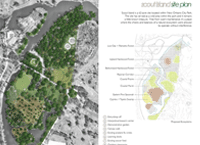
Scout Island is a 62-acre site located within New Orleans City Park. The site has served as a wild area within the park and it remains a little known treasure. Free from overt maintenance, it’s a place where the checks and balances of a natural ecosystem were allowed to operate without reference. (Photo: Mossop+Michaels)

Hurricane Katrina severely damaged Scout Island in August, 2005. Scout Island was under 6’ of water, destroying 50% of its vegetation and displacing many animal species that relied on it. Today, it is still rare to see many species that once inhabited the forest. (Photo: Mossop+Michaels)

A selected few of the over 200+ species of birds to have been sighted on Scout Island. (Photo: Mossop+Michaels)
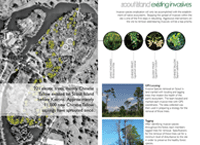
Invasive species eradication will only be accomplished with the establishment of native ecosystems. Stopping the spread of invasive within the site is one of the first steps in rebuilding. Aggressive interventions on the site to remove seed-bearing invasive will be a top priority. (Photo: Mossop+Michaels)
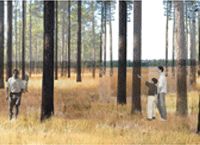
Perspective of Pine Savannah (Photo: Mossop+Michaels)

Section Through Entry Bridge. The establishment of new ecosystems focuses on re-creating a multi-storied canopy. (Photo: Mossop+Michaels)

Section Through water walk + Oak Grove. (Photo: Mossop+Michaels)
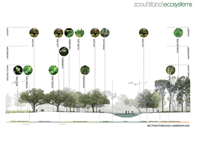
Section Through Harrison Ave. (Photo: Mossop+Michaels)
"Amazing site analysis and program providing a connection between city and park. The solutions are so beautiful and simple. The lack of prescription leaves it open for evolution. The landscape architect was light handed and provided a good process for the people who live there to have input into what happens."
— 2009 Professional Awards Jury

section through cypress swamp. Because of the salinity of the water on site, the Cypress Swamp was designed to use water falling on the site. (Photo: Mossop+Michaels)
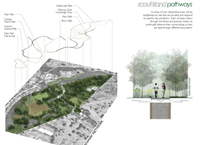
pathways. A series of new interpretive trails will be established on site that are durable and respond to specific site conditions. Tails will lead visitors through the forest and prompt visitors to continually observe their surroundings as they are lead through different ecosystems. (Photo: Mossop+Michaels)

pathways. (Photo: Mossop+Michaels)
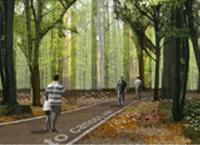
signage. Perspective of Signage: Signs denoting entry into ecosystems in the forest will be written into the pathway. (Photo: Mossop+Michaels)

canopy walk. The highest elevation within New Orleans exists on Scout Island. “The Mountain”, as it is referred to, was created by the debris from the construction of Interstate 610 and lies 25’ above sea level at its highest point. The design of a canopy walk will enhance the unique experience and provide the ability to walk in the canopy of the forest. (Photo: Mossop+Michaels)
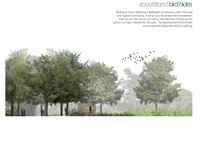
bird hides. Birding on Scout Island has a dedicated constituency within the local and regional community. It serves as a destination for birdwatchers from all over the country as well as internationally. Enhancing this activity is a major initiative for the park. The development of bird hides will increase the enjoyment of bird watching. (Photo: Mossop+Michaels)

educational infrastructure. Time-lapse cameras linked to a website will track the progress of the site’s development over a period of several years, remaining the public of the progress that has been made, as well as providing a new understanding of the processes that are happening on the site. (Photo: Mossop+Michaels)



